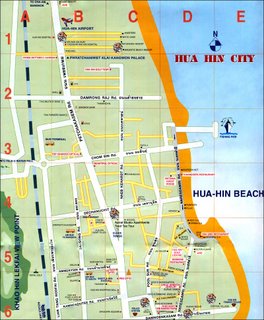Hua Hin is about 200 km south of Bangkok on the west coast of the
Gulf of Thailand.
Can be easily accessed by road (2 and half hour drive from Bangkok) - Taxis available here.
This charming seaside town can claim to being Thailand's oldest
beach resort. This status dates from 1926 when
King Rama VII built a beachside palace named
Klai Kangwan (Far From Worries) The Thai royal family still customarily spend the hottest months of the year, generally March through April, there. Many prominent Bangkok families maintain beachside villas.
Hua-Hin BeachThis was the first beach to gain fame and popularity with holiday makers in Thailand. It extends some three kilometers southwards from the fishing village and rocky headland (that gives
Hua Hin,
literally Rocky Head, its name) until a southern headland where
Buddhist temples cling to yet another, somewhat formidable cliff. Its crystal clear waters, clean white sand and wonderful atmosphere make it the number one choice and a dream resort for tourists, having never failed to delight visitors of all ages down the years. There is opportunity to do many water sports and horse riding on the beach.
Khao TakiabKhao Takiab or "
Chopstick Mount" is a large mount which juts out to sea and is capped with a temple at the top. It is located south of the town of
Hua Hin. In and around the temple, is quiet, cool and breezy.
Suan Son Pradiphat BeachThis beautiful stretch of beach is 9 km south of
Hua Hin, and takes it name from the "sun" or casuarinas pine trees which line the beach. Calm and peaceful, it is well cared for by the local army camp. There are plenty of restaurants.
The Royal Waiting RoomAt
Hua Hin railway station, this is one of oldest railway stations in Thailand, and its most striking feature is the unique
Royal Waiting Room in
Thai architectural style. The waiting room was moved from
Sanam Chan during the reign of
King Vajiravudh,
Rama 6.
Wang Klai Kang Won PalaceGraciously built beside Hua Hin Beach by King Prajadhipok, Rama7, Wang Klai Kang Won served as an alternative summer palace for His Majesty and Queen Rampai Phanee. Designed with a European architectural feel, the original name was "Suan Klai Kang Won" and "Phra Tamnak Piamsuk", meaning "The Garden Far From Worries" and "The Royal Residence Full of Happiness".
Wang Klai Kang Won Palace - Hua Hin - ThailandBesides the royal residence and beautifully manicured ornamental gardens full of kinds of plants and objects d'art from Java, one must also be sure to see the beautiful collection of shells in the shell museum.
King Prajadhipok (King Rama VII) built the Klai Kangwon Palace at Hua Hin as a summer home for Queen Rambai Barni. The palace was designed by Prince Iddhidehsarn Kridakara, an architect and the Director of the Fine Arts Department, and officially opened in 1929.
Originally, Klai Kangwon comprised three mansions, each facing the sea. The two-storey buildings housed the royals, while smaller houses in the vicinity were for the entourage. The architecture of the palace is basically Spanish, designed to admit the cooling sea breezes.
A formal garden in front of the mansions has stone sculptures from Bali, sundials, nautical instruments, lamps and other ornaments. A section is given over to topiary-bushes sculpted and trained into interesting shapes.
Their Majesties the King and Queen still stay at Klai Kangwon Palace when on trips to Prachuab Khiri Khan and surrounding areas.
Marukhathaiyawan Palace (Palace of Love and Hope)This beachside palace was formerly used as a royal summer residence by King Rama VI during the 1920s. The palace was designed by an Italian architect and built of golden teak.
Hua-Hin Night MarketDefinitely to be counted as
Hua Hin's most colorful nightly attraction. Every evening throngs of both Thai and overseas visitors will come to stroll around and take their pick from the many food stalls offering all kinds of freshly-prepared goodies. These includes Thai dishes, fresh seafood, Thai desserts and Indian roti bread. Besides the culinary delights, many other stalls offer visitors a host of memorable souvenirs.
National Parks Khao Sam Roi YotA mountain range with 300 peaks Sheltered in one of its several caves up in the hills is a royal pavilion, the main attraction for travelers prepared to go the distance.
Information : Hua Hin - Surrounding Area.

